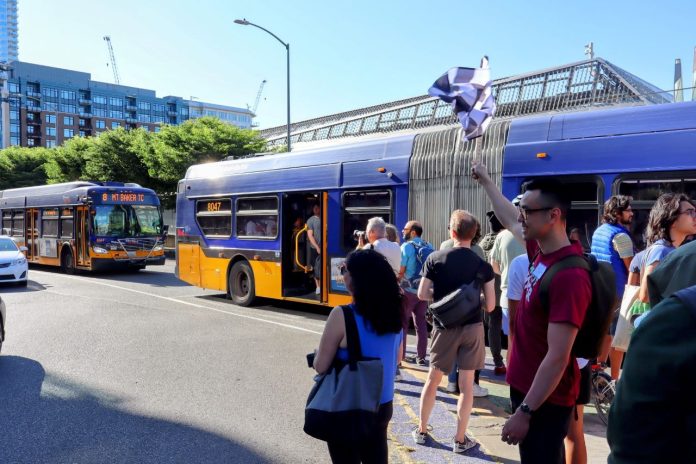
On a sunny Thursday afternoon earlier this month, more than 200 Seattle bus advocates raced King County Metro’s Route 8 on foot, some dancing, juggling, or hopscotching along the way. Despite their multitasking, most of them beat the notoriously slow bus rather easily. Advocates hope the event can spur the City of Seattle to install bus lanes and other route improvements to speed up the 8 through the troublesome bottleneck along Denny Way.
Organizers called their July 10 event “Race The L8.” Most of the participants completed the half-mile route in just over 16 minutes, traversing from Denny Way from Dexter Avenue to Stewart Street. The Route 8 bus, meanwhile, took 22 minutes to travel the half-mile stretch, averaging 1.4 miles per hour.
As one of the slowest and least reliable bus in King County Metro’s system, it hardly came as a surprise. In fact, bus riders have taken to calling the route “The Late” or “L8” to make light of an unfortunate situation. The group organizing to improve the beleaguered bus route calls itself “Fix The L8” — kicking off their efforts in an 2023 Urbanist op-ed.
“It’s abundantly clear that Route 8 has serious issues and needs to be fixed,” Fix The L8 wrote in a release. “In fact, it is the least reliable all-day route in King County Metro’s entire system, with eastbound on-time reliability regularly dropping below 40% on-time during evening rush hour, well below Metro’s goal of 80%. That’s why the Transit Riders Union and Central Seattle Greenways have been leading the Fix the L8 campaign for two years, pushing for full two-way bus lanes on Denny Way to bring Route 8 up to speed. The campaign’s latest action letter had participants sending over 15,000 emails to local leaders.”
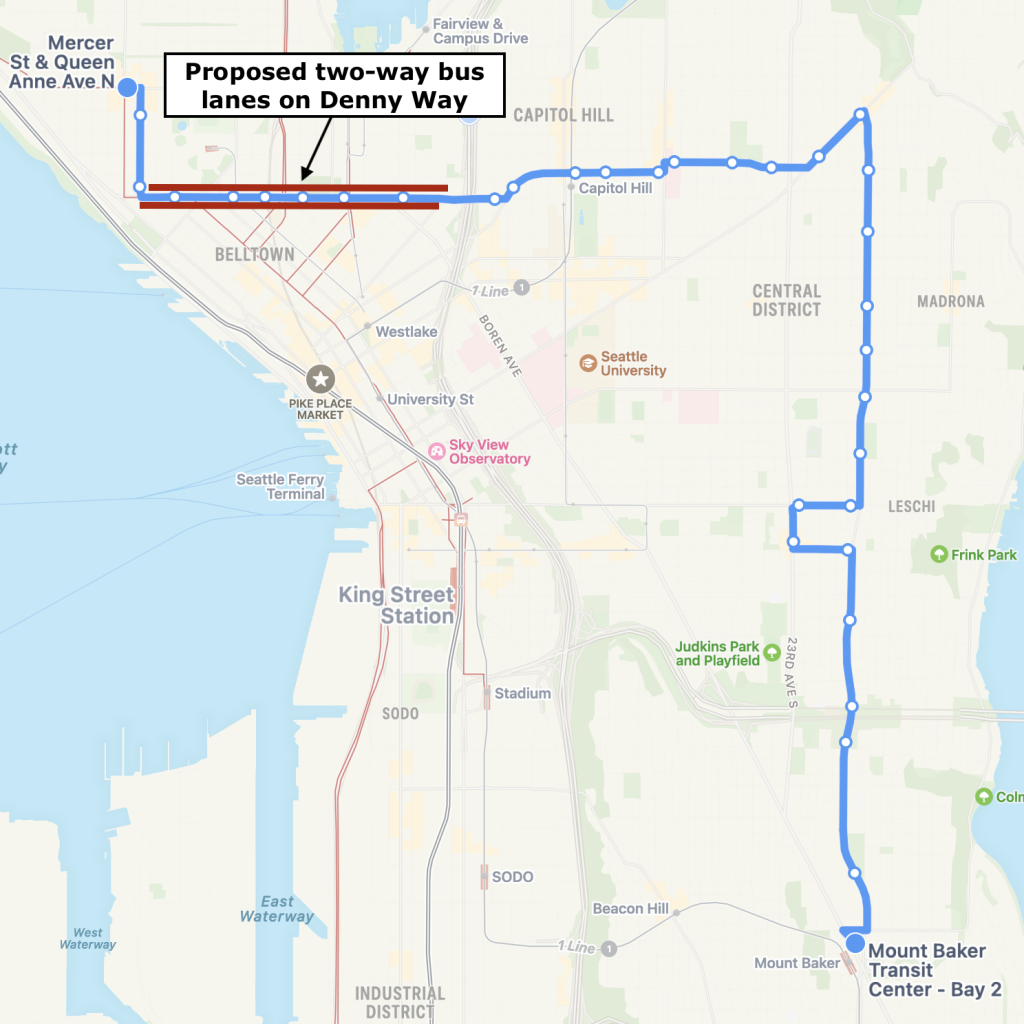
Nick Sattele, a volunteer with Fix The L8 and Central Seattle Greenways, said organizers were blown away by the turnout. He said showed the issue resonated with the general public, even if the sluggishness of Route 8 has long been ignored by policymakers.
“This is not seen as some niche little issue off to the side,” Sattele said. “It seemed like the city really did care.”
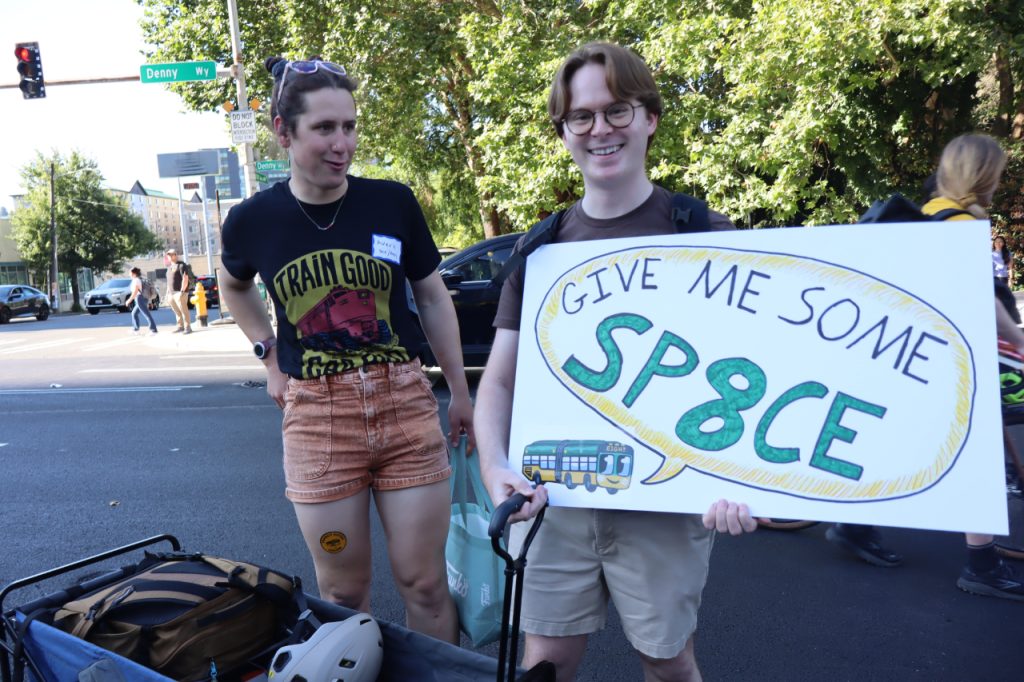
Candidates Wilson and Foster weigh in
While Sattele said no elected officials attended, several candidates for office were among the hundreds of participants. One of them was Katie Wilson, who is running for mayor with The Urbanist’s endorsement. Wilson is the general secretary of the Seattle Transit Riders Union and has long advocated for better service and more affordable fares over the course of her 15-year organizing career.
“My daughter and I arrived at the starting line fully on board with the spirit of the event, having waited 25 minutes for the bus to arrive at the Route 8 stop near our home on Capitol Hill,” Wilson told The Urbanist. “The crowd was amazing. People put so much good energy and creativity into their methods of locomotion, and in the end we beat the bus to the finish line.”
Why do riders call Metro Route 8 the L8? Come find out for yourself this Thursday, July 10th when we join TRU and Central Seattle Greenways to "Race the L8" – meet at 5pm in Denny Park near Dexter.
— Katie Wilson for Seattle (@wilsonforseattle.bsky.social) July 9, 2025 at 10:00 AM
[image or embed]
Seattle City Council candidate Dionne Foster also attended the event. Foster is running for citywide Position 9 against incumbent City Council President Sara Nelson, who has been hesitant to get behind bus upgrades, as she fought to derail Route 40 bus lanes — albeit unsuccessfully — and pushed for additional scrutiny for all future bus projects. In her Urbanist questionnaire, Foster called out the need for dedicated bus lanes and augmented service.

“Reallocating street space is a necessary step to meet Seattle’s climate goals, reduce emissions, and create healthier neighborhoods — particularly for communities most harmed by car-centric infrastructure,” Foster wrote. “On the Council, I will lead with a commitment to equity, drawing from successful examples and community engagement to build support for a more people-centered transportation system.”
Given the contrast on transit and other issues, The Urbanist Elections Committee (on which we serve as two of 14 members) went with Foster for our endorsement, hoping to break from the gridlocked status quo.
Beyond being fun, Wilson noted the message of the race came through crystal clear: bus lanes now.
“The event was a ton of fun, but our message was serious: It’s just not acceptable to have our public transit system be this slow and unreliable. Transportation infrastructure can be complicated but in this case the solution is simple: Bus lanes on Denny! Let’s get out the red paint.”
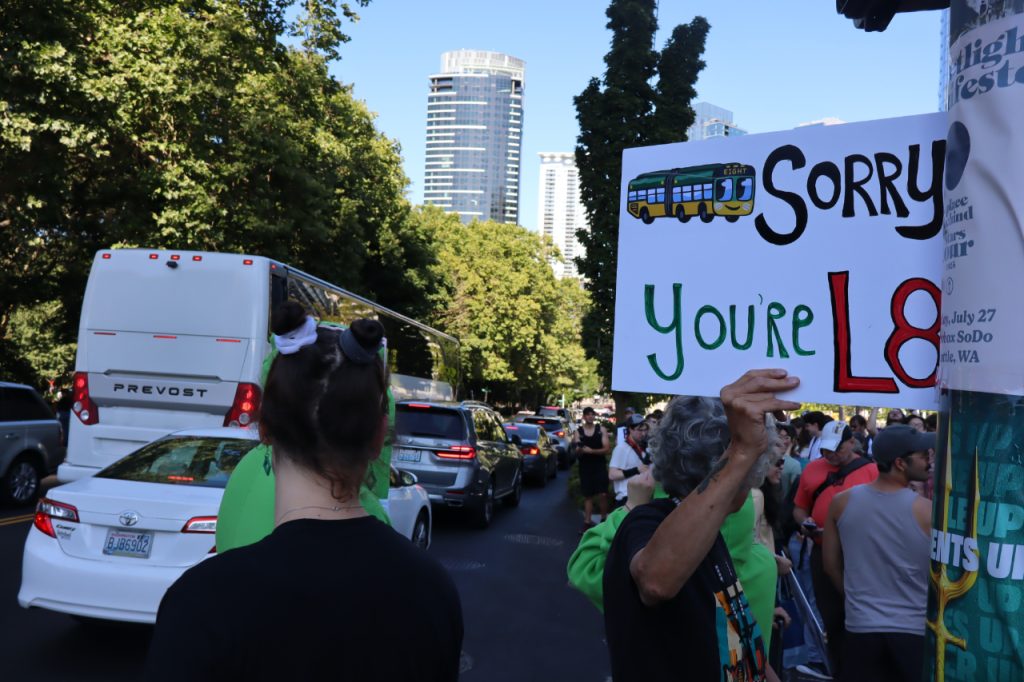
Fix The L8 argued that the “simple addition of red paint from 1st Avenue to Fairview could ensure smoother transit for thousands of passengers and dozens of drivers/buses along this vital route.” The one-mile segment is the most congested and slow for riders, though the route also encounters delays as it winds through Capitol Hill as well.
Along with The Urbanist and other climate and transportation groups, Wilson founded the Move All Seattle Sustainably (MASS) coalition, which pushed Seattle to add bus lanes to grapple with the long- and short-term impact of the Alaskan Way Viaduct replacement project.
Mayor Bruce Harrell recently backed out of one of the major concessions that the MASS Coalition won, which had been the pledge to extend the Third Avenue bus-only lanes farther into Belltown. As a result, more than 80,000 daily bus riders will have less reliable and speedy trips. Beyond the immediate pain of losing a promised bus mall extension, the move signaled to transit advocates that the City lacks vision to prioritize bus upgrades going forward.
Half-hearted Denny Way changes, little long-term vision
Route 8’s Denny Way stretch has long been identified as a chokepoint, but change has remained elusive. Despite lofty rhetoric, in practice, City leaders have continued to prioritize the street as an artery for cars and a funnel for I-5 traffic. In 2018, the Seattle Department of Transportation (SDOT) added a few short stretches of bus lanes on Denny Way, but failing to grapple with the key pinch points. In 2023, the Seattle Department of Transportation (SDOT) approved a $5 million repaving project (still underway today) that will essentially leave the street design as is.
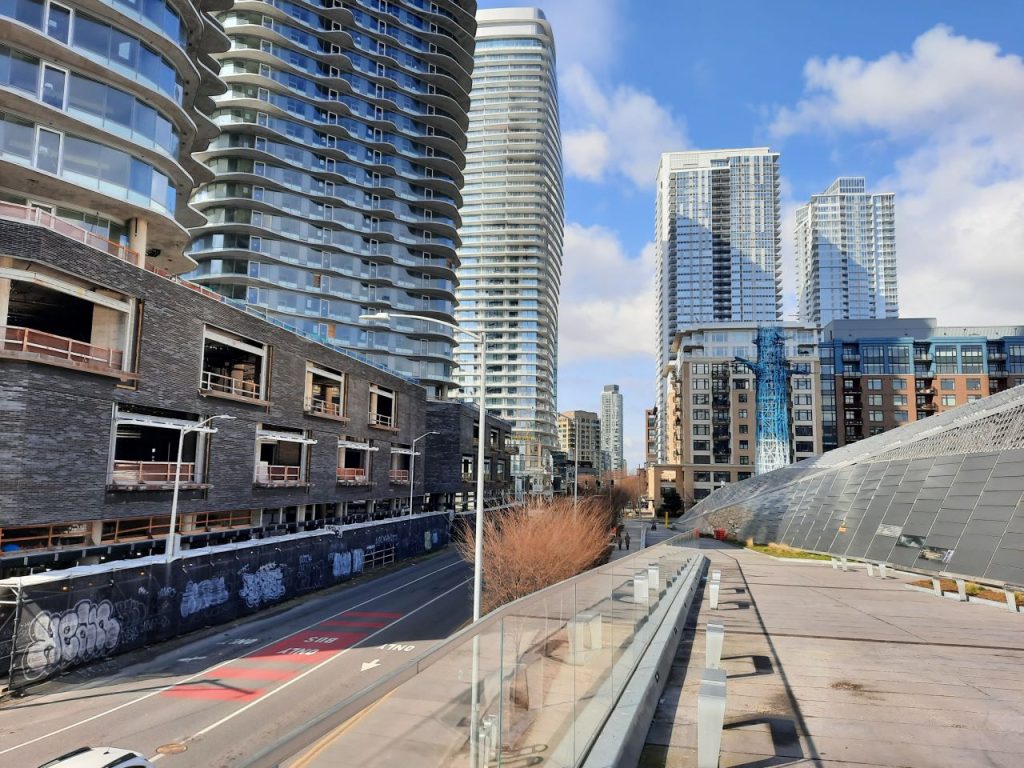
One reason that SDOT’s traffic operations division cited for keeping Denny Way as is and not making safety upgrades or bus improvements during the repaving is that the department recently sunk $12 million into traffic signal timing optimization (for cars) via the Denny Way Intelligent Traffic Signal (ITS) project. Rather than contemplating fundamental changes, the City appears to be focused on squeezing a bit more car-carrying capacity out of the traffic-clogged street.
In aerial footage that Fix The L8 volunteer Juan Rodriguez captured from a drone, the absurdity of a brand new street that fails to get any vehicles anywhere really comes out. That new asphalt looks nice, and bus riders and motorists sure get a lot of time to admire it.
“Over the past year or two, we’ve been talking to SDOT about speed and reliability improvements on Denny Way, and they’ve been doing a study,” Sattele told The Urbanist. “That study has finally wrapped up after a year and a half, and we’re hearing that they’re thinking about doing a small stretch of bus lane on Denny Way between Queen Anne Avenue and Third Avenue in Lower Queen Anne and Belltown. But it does not appear that the section where we race between Dexter and Stewart is in scope anymore.”
Instead of planning for transit improvements on Denny Way, SDOT increasingly is dwelling on Harrison Street as a parallel alternative bus route. However, King County Metro doesn’t appear to be on the same page, and continues to envision bus service on Denny Way. Since Harrison does not cross I-5, the bus would eventually need to use Denny Way (or another street that spans I-5) regardless — at least if continuing to serve Capitol Hill and the Central District is still the plan. A Harrison Street route appears pretty far away from implementation, even if Metro could be convinced.
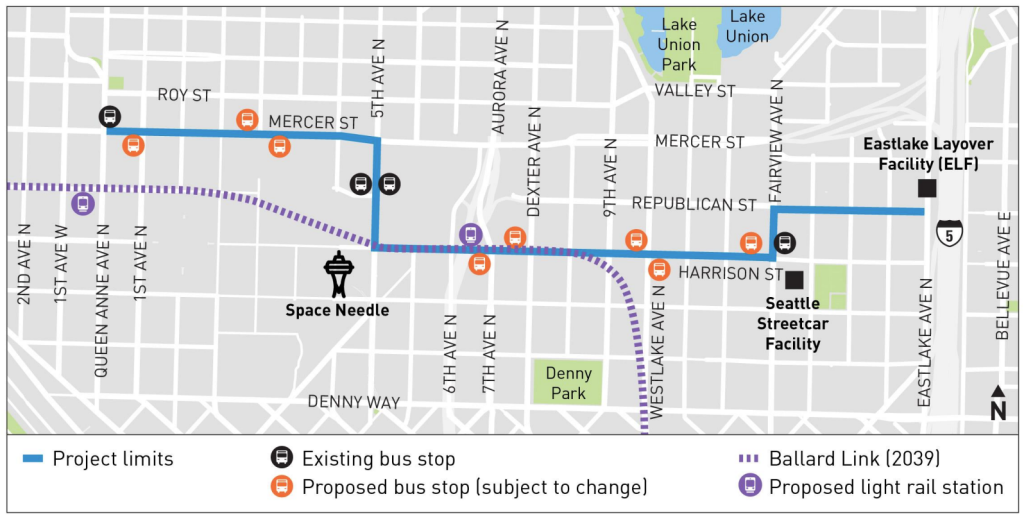
Denny Way traffic congestion is an issue that’s not likely to go away.
Neighborhoods along Route 8 — such as Lower Queen Anne, Denny Triangle, South Lake Union, and Capitol Hill — continue to lead the city in housing and job growth. The housing boom along Denny Way has been monumental — back in 2017, The Urbanist highlighted the more than 10,000 new homes that were in development within a few blocks of Denny Way. Many of those planned units have since been completed, and more are on the way, including a 53-story apartment tower that recently earned its permit approval.
In the Denny Triangle, a land use application for a 53-story apartment building with 569 homes, office, and retail has been approved. services.seattle.gov/portal/custo…
— The Urbanist (@theurbanist.org) July 11, 2025 at 9:14 AM
[image or embed]
Seattle recently blew past the 800,000 population mark after growing rapidly over the past two decades, adding more than 200,000 residents — and much of that growth has been in its downtown core. That is putting added importance in upgrading roads to handle the additional trips, which are increasingly happening in modes other than cars. Officially, City plans call for leaning into that trend and embracing mode shift and less car dependency. In practice, the pull of the status quo is strong.
With Amazon’s headquarters in South Lake Union, and Google, Facebook, and Apple also occupying significant office footprints in the area, the demands on the local street grid are enormous. However, Route 8’s infamous unreliability is also pushing more people to drive or use ridehailing services for trips in the corridor than otherwise would. That is keeping the street trapped in a perpetual state of failure, letting all road users down, particularly during rush hour.
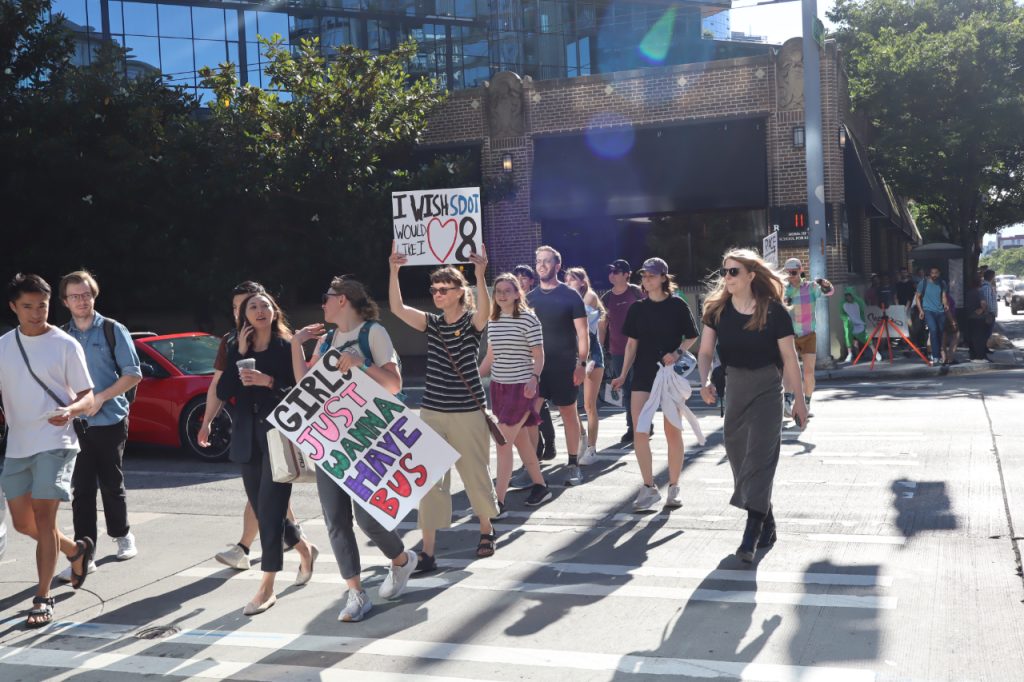
Fix The L8 advocates also flagged that the opening of the 2 Line extension in 2026, which will bring Judkins Park Station online, will add another major destination to the bus route, at its nexus with I-90, where the light rail line will travel. Route 8 will be the major feeder line bringing the MLK Way corridor to the 2 Line.
Some of my favorite pics from tonight's amazing Race the L8 event.
— Ryan Packer (@typewriteralley.bsky.social) July 10, 2025 at 8:35 PM
[image or embed]
Scant alternatives exist for traveling between North Downtown and Capitol Hill. The presence of I-5 plowing between the two mega-neighborhoods leave only a few streets spanning the freeway chasm. That helps explain why Route 8 continues to attract considerable ridership even as it’s so slow and unreliable.
“Despite these problems, Route 8 continues to be extremely popular, with nearly 7,000 daily riders choosing to ride the bus despite it being slower than walking,” Fix The L8 said. “Route 8 has the highest ridership per service hour invested out of any route that King County Metro operates at rush hour and is in the top four at all times. It is unacceptable that the city has allowed such a popular route to languish for so long.”
Advocates pointed to next year’s World Cup festivities as a deadline to make improvements or risk embarrassment on the international stage.
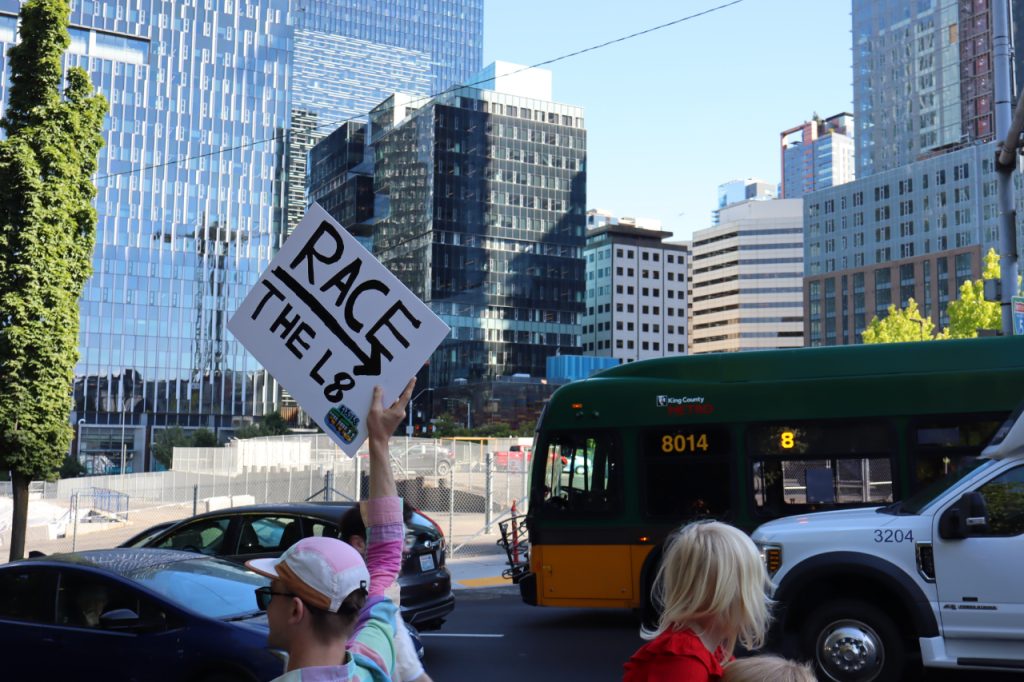
“Ridership for the route will increase next year as it connects to the long overdue Judkins Park Link Station which will open with East Link and as Seattle Center hosts a World Cup Fan Celebration,” Fix The L8 continued. “The city must act quickly to prevent our transit system from embarrassing the city and letting down thousands of visitors.”
The $1.55 billion transportation levy that Seattle passed in 2024 promised transit improvements to voters, and advocates argued they should follow through and put that funding to good use.
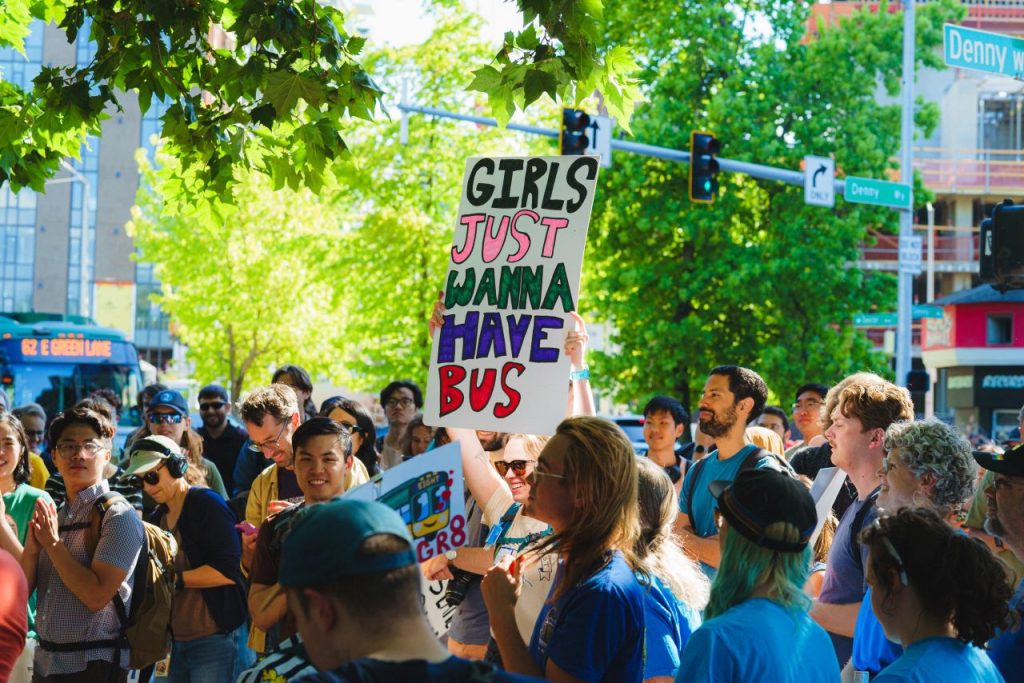
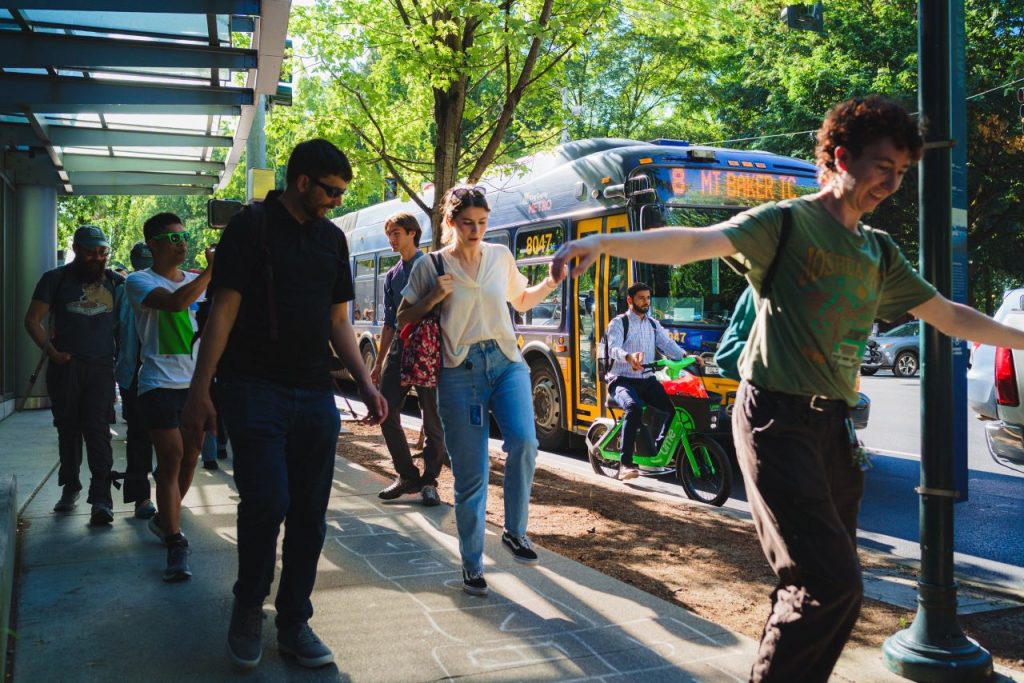
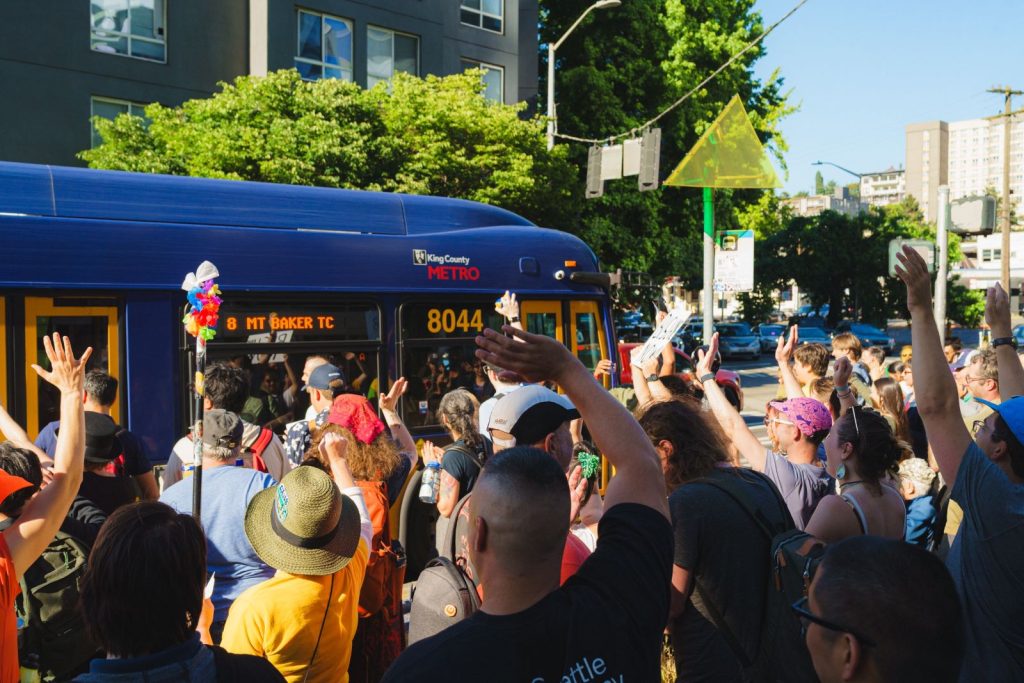
“It’s clear that there is extremely strong demand for the route and ridership would undoubtedly explode after the installation of bus lanes as the improvements would entice drivers to leave their cars at home,” Fix The L8 wrote. “We call on city leaders to act boldly and swiftly to implement this project approved by voters in the 2024 Transportation Levy.”
The group isn’t planning any more Route 8 races in the near future, but they do hope that this month’s event can galvanize the city to action.
“I hope that the event raises people’s understanding of routing and the absurdity of how slow it is, especially people at SDOT and in the mayor’s office who have the power to fix this,” Sattele said.
- Take Action: Sign Fix The L8’s letter here.


